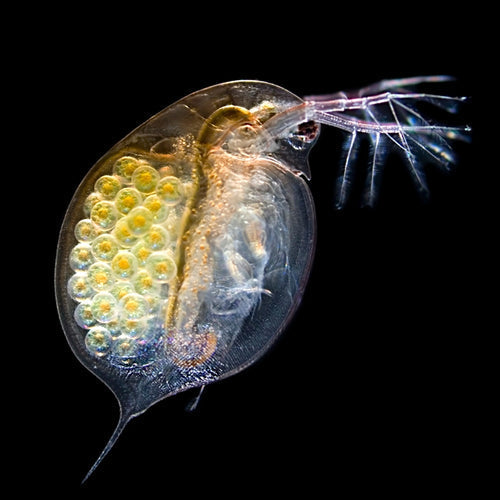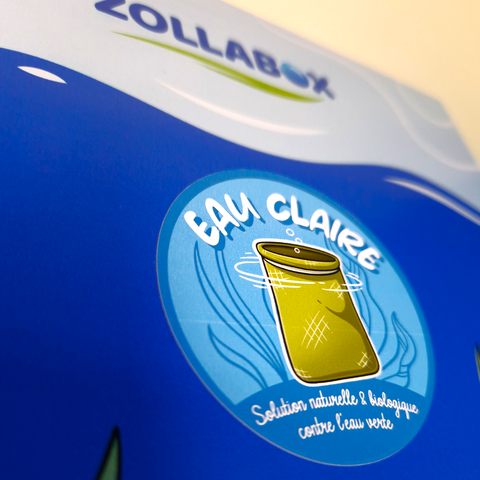
Giving daphnia to your fish: 7 points to know
F. MattierShare
1 – The daphnia is a freshwater crustacean.
Unlike artemia (sea shrimp), daphnia is part of the normal diet of freshwater fish in the wild. Its microbiota is fully adapted to this non-salty environment. It lives and reproduces there as long as it is not eaten, unlike artemia. The nauplii of daphnia are about twice as small as artemia nauplii (0.2 mm compared to 0.4 mm).
2 – The daphnia is rich in protein.
The analyses show a very high protein content, approaching 60%. This explains the lower value of the daphnia dried, as some fragile proteins are degraded by drying. A live daphnia exactly meets the nutritional needs of almost all fish, which have adapted to it for millennia. A study showed a growth rate of 150% (more than double) between fry fed with daphnia and those fed with dry food.

3 – Almost all females
Almost all the daphnia are females. They reproduce by parthenogenesis, each daughter being a clone of her mother: females giving birth to females! When conditions become difficult (for example, before winter), the daphnia produce a few males and then reproduce, one last time, sexually. They then lay black eggs (stuck in pairs) called ephippia, which survive for a long time waiting for favorable conditions to return. Therefore, a breeding is often not lost, even if no daphnia can be seen!
4 – Green Water Eater
The daphnia primarily feeds on phytoplankton, which means microscopic algae suspended in water. It feeds by filtering the green water, hence its use to combat green water in aquariums.
In the absence of phytoplankton, the daphnia can settle for (as a second choice) bacteria, yeasts, or even organic matter dissolved in the water.
5 – A varied microbiome
The daphnia is a small animal, but just as complex as a larger one. For example, its digestive tract is populated, like ours, by a microbiome. Like ours, it is all the more complex when it is healthy and properly nourished. This rich microbiome is partly released into the water with the excrement of the daphnia . The water in which daphnia have lived, even when they are no longer visible, is therefore alive and carries a host of bacteria beneficial to the aquatic ecosystem.
6 – A hyper-sensitive animal to light
It has been discovered that the daphnia, which evolve in clouds like fish swim in schools, change position in the water column according to the light, both day and night. Scientists explain that the decline of daphnia in natural environments would be the result of human-caused light pollution, which strongly disturbs them at night.
7 – The chameleon daphnia
It is very difficult to determine the species of certain daphnia (there are hundreds of them), as their appearance can vary so much. Depending on diet, season, climate, etc., the same species will have neither the same size nor the same shape. It has even been noticed that in the presence of fish in their environment, the daphnia develop a longer spiny spur, which makes them less attractive to fish.




17 comments
Bonjour
Bestiole fascinante effectivement et lorsqu elle se plaît elle se multiplie facilement
Dommage qu en présence de larves de moustique sa population diminue voire s efface
Solution ! Utiliser l épuisette de la zollabox pour attraper les moustiques et les donner aux poissons qui les adorent en entrée 😊😊
Bon on emmène quelques daphnies et ostracodes dans l opération mais c est à la marge !
Merci Martine pour ce bel outil qu est l épuisette à petites bestioles
Bonne journée à tous
Nadège
Je me suis mis à en enlever avec une souche aquazolla. Principalement pour démarrer un lowtech de 300l. J’en avais mis plusieurs centaines dans le bac ( elles formaient un grand banc) mais au bout d’un mois plus aucune n’est visible. Quelle peut être la raison. ( Il n’y a pas de poissons dans le bac encore. )
Très très intéressant article, j’élève des daphnies grâce à vous (entre autre), j’ai juste un soucis, mon eau stagnante est devenue trouble et sent très fort, il y a bien de la vie dedans mais je doute qu’il y ait encore des daphnies, alors que le bac en était plein, est-il possible que l’eau ai “tournée” et que les daphnies soient mortes? (Je les nourris à l’eau verte et poudre de spiruline), il y a des feuilles de chêne et un peu de cattapa, et une population d’escargots.
Très très intéressant article, j’élève des daphnies grâce à vous (entre autre), j’ai juste un soucis, mon eau stagnante est devenue trouble et sent très fort, il y a bien de la vie dedans mais je doute qu’il y ait encore des daphnies, alors que le bac en était plein, est-il possible que l’eau ai “tournée” et que les daphnies soient mortes? (Je les nourris à l’eau verte et poudre de spiruline), il y a des feuilles de chêne et un peu de cattapa, et une population d’escargots.
Daphné est elle une grande daphnie?